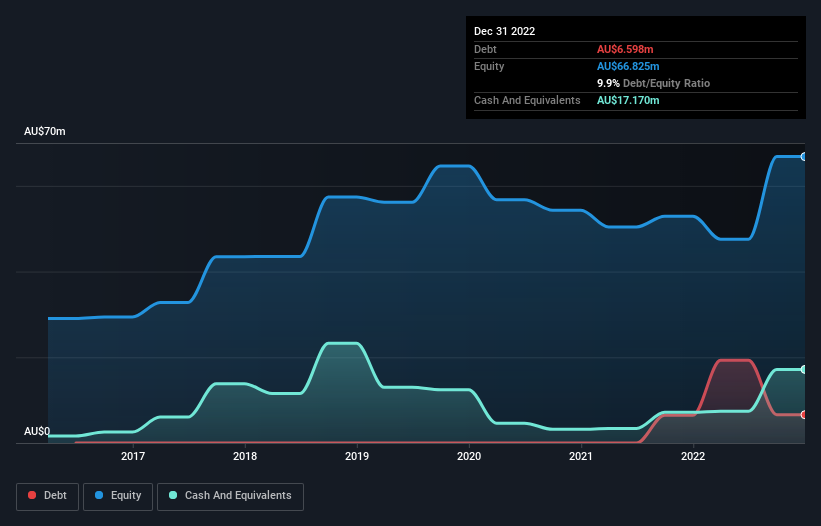Warren Buffett famously said, 'Volatility is far from synonymous with risk.' When we think about how risky a company is, we always like to look at its use of debt, since debt overload can lead to ruin. As with many other companies Comet Ridge Limited (ASX:COI) makes use of debt. But is this debt a concern to shareholders?
When Is Debt Dangerous?
Debt assists a business until the business has trouble paying it off, either with new capital or with free cash flow. In the worst case scenario, a company can go bankrupt if it cannot pay its creditors. However, a more usual (but still expensive) situation is where a company must dilute shareholders at a cheap share price simply to get debt under control. Of course, plenty of companies use debt to fund growth, without any negative consequences. The first thing to do when considering how much debt a business uses is to look at its cash and debt together.
View our latest analysis for Comet Ridge
How Much Debt Does Comet Ridge Carry?
The chart below, which you can click on for greater detail, shows that Comet Ridge had AU$6.60m in debt in December 2022; about the same as the year before. But it also has AU$17.2m in cash to offset that, meaning it has AU$10.6m net cash.

A Look At Comet Ridge's Liabilities
Zooming in on the latest balance sheet data, we can see that Comet Ridge had liabilities of AU$34.3m due within 12 months and liabilities of AU$13.7m due beyond that. On the other hand, it had cash of AU$17.2m and AU$103.0k worth of receivables due within a year. So it has liabilities totalling AU$30.7m more than its cash and near-term receivables, combined.
While this might seem like a lot, it is not so bad since Comet Ridge has a market capitalization of AU$121.2m, and so it could probably strengthen its balance sheet by raising capital if it needed to. However, it is still worthwhile taking a close look at its ability to pay off debt. Despite its noteworthy liabilities, Comet Ridge boasts net cash, so it's fair to say it does not have a heavy debt load! There's no doubt that we learn most about debt from the balance sheet. But ultimately the future profitability of the business will decide if Comet Ridge can strengthen its balance sheet over time. So if you're focused on the future you can check out this free report showing analyst profit forecasts.
Since Comet Ridge doesn't have significant operating revenue, shareholders must hope it'll sell some fossil fuels, before it runs out of money.
So How Risky Is Comet Ridge?
We have no doubt that loss making companies are, in general, riskier than profitable ones. And in the last year Comet Ridge had an earnings before interest and tax (EBIT) loss, truth be told. Indeed, in that time it burnt through AU$11m of cash and made a loss of AU$9.8m. With only AU$10.6m on the balance sheet, it would appear that its going to need to raise capital again soon. Summing up, we're a little skeptical of this one, as it seems fairly risky in the absence of free cashflow. The balance sheet is clearly the area to focus on when you are analysing debt. But ultimately, every company can contain risks that exist outside of the balance sheet. We've identified 5 warning signs with Comet Ridge (at least 2 which are potentially serious) , and understanding them should be part of your investment process.
When all is said and done, sometimes its easier to focus on companies that don't even need debt. Readers can access a list of growth stocks with zero net debt 100% free, right now.
New: AI Stock Screener & Alerts
Our new AI Stock Screener scans the market every day to uncover opportunities.
• Dividend Powerhouses (3%+ Yield)
• Undervalued Small Caps with Insider Buying
• High growth Tech and AI Companies
Or build your own from over 50 metrics.
Have feedback on this article? Concerned about the content? Get in touch with us directly. Alternatively, email editorial-team (at) simplywallst.com.
This article by Simply Wall St is general in nature. We provide commentary based on historical data and analyst forecasts only using an unbiased methodology and our articles are not intended to be financial advice. It does not constitute a recommendation to buy or sell any stock, and does not take account of your objectives, or your financial situation. We aim to bring you long-term focused analysis driven by fundamental data. Note that our analysis may not factor in the latest price-sensitive company announcements or qualitative material. Simply Wall St has no position in any stocks mentioned.
About ASX:COI
Comet Ridge
Engages in the oil and gas exploration, appraisal, and development activities in Australia.
Moderate growth potential with low risk.
Similar Companies
Market Insights
Community Narratives



